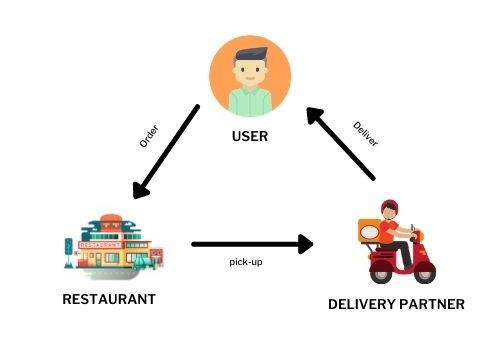Politics
How To Create An Food Delivery App Like UberEats?
Published
3 years agoon
By
Drew Simpson
If you are thirsty enough to set up your food delivery business, this blog will quench your thirst with essential insights. Firstly, you must understand the need to enter the food delivery industry. Though many business ideas are on par with the food delivery business, the scope and profit involved in food delivery services are unmatchable.
Create an App Like UberEats
It is a known fact that people love ordering food online through various platforms. In comparison to restaurant-to-consumer delivery, platform-to-consumer delivery gets all the attention from the user. Here are statistics that will validate the above-said statement.
“As per Statista, the platform-to-consumer delivery is the largest segment in the food delivery sector. Also, the revenue from this platform will be $79,608 million in the year 2021.”
With this data, let us move on to the different aspects involved in creating a food delivery business like UberEats.
UberEats – King Of Food Delivery Apps
UberEats is the subsidiary of Uber that was launched in the year 2014. Initially, Uber launched its vertical in the food delivery services with the name UberFresh. Later in the year, 2015, the company was renamed as UberEats.
Over the formative years, UberEats has grown into a massive food delivery giant serving 45 countries and more than 6000 cities worldwide. Apart from this, let us take a tour of the statistics of UberEats that includes various data on the growth and popularity of UberEats.
- As per Business Of Apps, UberEats fetched a revenue of $4.8 billion in the year 2020.
- During the pandemic times, the number of orders surpassed $30 million and saw an increase of 30% in comparison to the previous year.
- As per the year 2020, UberEats has a user base of 66 million worldwide, which is thrice that of the year 2019.
We shall take off from here and land on the business model of UberEats.
Business Model Followed By UberEats
UberEats follows a three-sided marketplace model that connects users, restaurants, and delivery personnel. Starting, a user will register on the app and select a restaurant to order from. The concerned restaurant will get the order notification. Meanwhile, the delivery person will be allocated who is situated nearby to the restaurant. Once the order gets prepared, the delivery person will pick it up and deliver it to the user.
Unique Selling Point Of UberEats
Be it any kind of business, it is necessary to offer something unique to users, which is the key to sustain among the competition. Here, let us take a glimpse at the unique selling points of UberEats.
- UberEats deliver their orders in under 30 minutes. The maximum average delivery time is 35.31 seconds.
- The company has established partnerships with multiple local restaurants and hence stands by the motto, “We don’t want your food traveling halfway across the town.”
- There are many food delivery apps that employ a minimum order policy. But UberEats doesn’t employ the minimum order delivery, which is also another factor for the increased user base.
- Another interesting fact regarding the USP of UberEats that they are quite active in their social media handles. A user can approach them on social media handles regarding any order-related queries. They solve the issue in a jiffy.
We live in a competitive environment where there are plenty of rivalries in a given business segment. Therefore, having a unique selling proposition is the ultimate key to keep your business afloat.
Until here, we toured on the statistics and popularity of UberEats. Next, we shall head to the need to develop an app like UberEats for your food delivery services venture.
How to launch your food ordering app like UberEats effortlessly?
In general, app development consumes time and money depending on the complexity of the app development project. The clone app development is the alternative to the traditional app development process. To be precise, in the clone method of app development, your app developer will give you a fully functional app. If you wish, you can personalize the app with your preferred set of features and UI themes.
In this regard, you can go for the development of UberEats like an app that is a hot topic on the Internet. In the upcoming sub-topics, we will learn the stages of app development, features, money-making channels, etc.
Before delving into the app development stage, let us analyze the factors to be considered while developing your food ordering app.
Prioritize these things while developing your app like UberEats

Purpose of your business
Identifying the purpose of the business is also called concept proofing. You have to work on the challenges faced by people and design a solution that can come as a saviour. For example, when people were struggling with the lockdown restrictions, the grocery delivery services came as a rescue. Similarly, pick out the challenges and stuff people with your business solutions.
Target audience
Once you have framed out your business solution, you must identify the end-users. The question here is how to identify the end-users. To find out users, you must prepare a questionnaire and circulate it over the Internet. From the inputs, you can easily identify the pain points and convert them into your users.
Business model
We have reached one of the crucial stages of the food delivery service business. You have to shortlist a business model that you think will align with your requirements and budget. In the case of the food delivery business, there are multiple business models. They are
In the case you opt for the order-only model, users will be able to only order food via your app. The delivery of the orders will be the responsibility of the concerned restaurants.
As the name itself is suggestive, you will take care of both the order acceptance and delivery if you employ this model. In this model, either you or your restaurant can look after the delivery services. The choice lies with you and your restaurant partner.
The fully integrated model applies if you own a restaurant or chain of restaurants. You will implement an online ordering system and take care of the deliveries all by yourself.
Therefore, these are the business models associated with food delivery services.
Mobile platforms
Let us assume that you have proposed a business solution, found out the target audience, and also picked out the business model. Now, you are one step away from delivery app development. Here comes the crucial phase in which you have to identify the mobile platforms in which you wish to deploy the app.
Similar to identifying the target audience, you must also identify the mobile platform that has a wider user base. When it comes to selecting the mobile platform, you can go for Android, iOS, or both.
Design
Design is another imperative stage in app development. While designing your app, make it visually appealing as well as easy to navigate. The user interface will decide the engagement of users. Therefore, keep the UI as minimalistic as possible.
Another important thing to consider is, do not to annoy your users with constant push notifications. Agreeing to the fact that push notifications are the direct way to attract users yet, you must limit the number of push notifications you send.
App development
After all, you must pay heed to the app development process. Here, you can either go for traditional app development or clone app development. How do they differ? In the case of traditional app development, your app developer will start from the prototype and gradually add the functionalities one by one. This method may take years to get a fully functional app. Also, the cost of development will also increase simultaneously.
As discussed earlier, you can choose the UberEats clone script that strikes out the hefty investment of time and money, unlike traditional app development.
Highly essential features of the food delivery app like UberEats — make your app like this:

Track orders
Users must get constant information about their orders. Hence, the order tracking feature is a must. Through this feature, users will know the status of their orders and the location of delivery persons as well.
Schedule orders
The scheduling feature will come in handy when users wish to book their orders in advance for a later date.
Payments
Add multiple payment options that let users pay through their convenient payment options. By integrating different payment options, you will never have to miss out on any users.
Order history
Users can easily have knowledge about previous orders via the order history.
GPS
The GPS is a mandatory feature in your app that will help the delivery persons in finding the user’s location easily.
We have almost reached the end of this write-up, and there is only one sub-topic left: the revenue streams. Come, let us discuss the different revenue streams of the food delivery business.
Revenue channels of food delivery business
- Delivery charges
- Commission fees
- Advertising fees
Summing up, I believe that you would have definitely enjoyed reading this blog and found it informative. All the best for your food delivery business like UberEats!
Jennifer Atkinson
Chief Technical Writer
Jennifer is an America-based chief technical writer at Appdupe, who has got the buzz of every faddish development in the technology and app development sector. Her verdict about presenting quick-witted solutions to the current issues and being enigmatic about future trends has led her to become the wizard in her field.
You may like
-


Chinese apps are letting public juries settle customer disputes
-


The Download: AI coding assistants, and China’s app disputes
-


Users are doling out justice on a Chinese food delivery app
-


Google DeepMind’s new AI tool helped create more than 700 new materials
-


This Chinese map app wants to be a super app for everything outdoors
-


The Mobile App Dilemma: to Build or Not to Build, That is the Question
Politics
Fintech Kennek raises $12.5M seed round to digitize lending
Published
7 months agoon
10/11/2023By
Drew Simpson
London-based fintech startup Kennek has raised $12.5 million in seed funding to expand its lending operating system.
According to an Oct. 10 tech.eu report, the round was led by HV Capital and included participation from Dutch Founders Fund, AlbionVC, FFVC, Plug & Play Ventures, and Syndicate One. Kennek offers software-as-a-service tools to help non-bank lenders streamline their operations using open banking, open finance, and payments.
The platform aims to automate time-consuming manual tasks and consolidate fragmented data to simplify lending. Xavier De Pauw, founder of Kennek said:
“Until kennek, lenders had to devote countless hours to menial operational tasks and deal with jumbled and hard-coded data – which makes every other part of lending a headache. As former lenders ourselves, we lived and breathed these frustrations, and built kennek to make them a thing of the past.”
The company said the latest funding round was oversubscribed and closed quickly despite the challenging fundraising environment. The new capital will be used to expand Kennek’s engineering team and strengthen its market position in the UK while exploring expansion into other European markets. Barbod Namini, Partner at lead investor HV Capital, commented on the investment:
“Kennek has developed an ambitious and genuinely unique proposition which we think can be the foundation of the entire alternative lending space. […] It is a complicated market and a solution that brings together all information and stakeholders onto a single platform is highly compelling for both lenders & the ecosystem as a whole.”
The fintech lending space has grown rapidly in recent years, but many lenders still rely on legacy systems and manual processes that limit efficiency and scalability. Kennek aims to leverage open banking and data integration to provide lenders with a more streamlined, automated lending experience.
The seed funding will allow the London-based startup to continue developing its platform and expanding its team to meet demand from non-bank lenders looking to digitize operations. Kennek’s focus on the UK and Europe also comes amid rising adoption of open banking and open finance in the regions.
Featured Image Credit: Photo from Kennek.io; Thank you!
Radek Zielinski
Radek Zielinski is an experienced technology and financial journalist with a passion for cybersecurity and futurology.
Politics
Fortune 500’s race for generative AI breakthroughs
Published
7 months agoon
10/11/2023By
Drew Simpson
As excitement around generative AI grows, Fortune 500 companies, including Goldman Sachs, are carefully examining the possible applications of this technology. A recent survey of U.S. executives indicated that 60% believe generative AI will substantially impact their businesses in the long term. However, they anticipate a one to two-year timeframe before implementing their initial solutions. This optimism stems from the potential of generative AI to revolutionize various aspects of businesses, from enhancing customer experiences to optimizing internal processes. In the short term, companies will likely focus on pilot projects and experimentation, gradually integrating generative AI into their operations as they witness its positive influence on efficiency and profitability.
Goldman Sachs’ Cautious Approach to Implementing Generative AI
In a recent interview, Goldman Sachs CIO Marco Argenti revealed that the firm has not yet implemented any generative AI use cases. Instead, the company focuses on experimentation and setting high standards before adopting the technology. Argenti recognized the desire for outcomes in areas like developer and operational efficiency but emphasized ensuring precision before putting experimental AI use cases into production.
According to Argenti, striking the right balance between driving innovation and maintaining accuracy is crucial for successfully integrating generative AI within the firm. Goldman Sachs intends to continue exploring this emerging technology’s potential benefits and applications while diligently assessing risks to ensure it meets the company’s stringent quality standards.
One possible application for Goldman Sachs is in software development, where the company has observed a 20-40% productivity increase during its trials. The goal is for 1,000 developers to utilize generative AI tools by year’s end. However, Argenti emphasized that a well-defined expectation of return on investment is necessary before fully integrating generative AI into production.
To achieve this, the company plans to implement a systematic and strategic approach to adopting generative AI, ensuring that it complements and enhances the skills of its developers. Additionally, Goldman Sachs intends to evaluate the long-term impact of generative AI on their software development processes and the overall quality of the applications being developed.
Goldman Sachs’ approach to AI implementation goes beyond merely executing models. The firm has created a platform encompassing technical, legal, and compliance assessments to filter out improper content and keep track of all interactions. This comprehensive system ensures seamless integration of artificial intelligence in operations while adhering to regulatory standards and maintaining client confidentiality. Moreover, the platform continuously improves and adapts its algorithms, allowing Goldman Sachs to stay at the forefront of technology and offer its clients the most efficient and secure services.
Featured Image Credit: Photo by Google DeepMind; Pexels; Thank you!
Deanna Ritchie
Managing Editor at ReadWrite
Deanna is the Managing Editor at ReadWrite. Previously she worked as the Editor in Chief for Startup Grind and has over 20+ years of experience in content management and content development.
Politics
UK seizes web3 opportunity simplifying crypto regulations
Published
7 months agoon
10/10/2023By
Drew Simpson
As Web3 companies increasingly consider leaving the United States due to regulatory ambiguity, the United Kingdom must simplify its cryptocurrency regulations to attract these businesses. The conservative think tank Policy Exchange recently released a report detailing ten suggestions for improving Web3 regulation in the country. Among the recommendations are reducing liability for token holders in decentralized autonomous organizations (DAOs) and encouraging the Financial Conduct Authority (FCA) to adopt alternative Know Your Customer (KYC) methodologies, such as digital identities and blockchain analytics tools. These suggestions aim to position the UK as a hub for Web3 innovation and attract blockchain-based businesses looking for a more conducive regulatory environment.
Streamlining Cryptocurrency Regulations for Innovation
To make it easier for emerging Web3 companies to navigate existing legal frameworks and contribute to the UK’s digital economy growth, the government must streamline cryptocurrency regulations and adopt forward-looking approaches. By making the regulatory landscape clear and straightforward, the UK can create an environment that fosters innovation, growth, and competitiveness in the global fintech industry.
The Policy Exchange report also recommends not weakening self-hosted wallets or treating proof-of-stake (PoS) services as financial services. This approach aims to protect the fundamental principles of decentralization and user autonomy while strongly emphasizing security and regulatory compliance. By doing so, the UK can nurture an environment that encourages innovation and the continued growth of blockchain technology.
Despite recent strict measures by UK authorities, such as His Majesty’s Treasury and the FCA, toward the digital assets sector, the proposed changes in the Policy Exchange report strive to make the UK a more attractive location for Web3 enterprises. By adopting these suggestions, the UK can demonstrate its commitment to fostering innovation in the rapidly evolving blockchain and cryptocurrency industries while ensuring a robust and transparent regulatory environment.
The ongoing uncertainty surrounding cryptocurrency regulations in various countries has prompted Web3 companies to explore alternative jurisdictions with more precise legal frameworks. As the United States grapples with regulatory ambiguity, the United Kingdom can position itself as a hub for Web3 innovation by simplifying and streamlining its cryptocurrency regulations.
Featured Image Credit: Photo by Jonathan Borba; Pexels; Thank you!
Deanna Ritchie
Managing Editor at ReadWrite
Deanna is the Managing Editor at ReadWrite. Previously she worked as the Editor in Chief for Startup Grind and has over 20+ years of experience in content management and content development.
